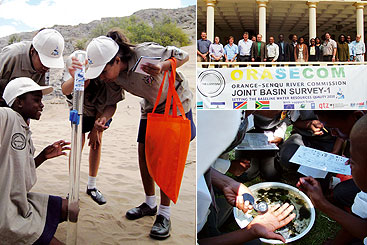Planning the first Joint Basin Survey for the Orange-Senqu River Basin

Planning the first Joint Basin Survey
for the Orange-Senqu River Basin
The ICPDR looks beyond the basin for inspiration and ideas, and working with other river basins provides an opportunity to share knowledge, and learn from similar challenges and experiences to see the Danube through other perspectives.

Left: Local children will help
test the water, gather
samples and make a
judgement on the health
of the river. Their data
will be valuable for the
survey, but their participation
is even more
crucial to ensure action
on water issues by future
generations.
Right: Bringing two basins
together: lessons learnt
in the two Joint Danube
Surveys are helping form
ORASECOM’s Joint
Basin Survey, and the
ICPDR has much to learn
from ORASECOM’s
approaches to surveying
non-navigable rivers.
The ICPDR forges alliances around the world to share experiences on integrated river basinmanagement and to develop innovative and collaborative solutions to water quality and quantity pressureswith other international river basins.
The ICPDR has developed ties with the Orange-Senqu River Commission (ORASECOM) in southern Africa. Exchange visits between the two organisations have strengthened links between the two commissions and led to shared ideas on several issues – interactions that have already proven valuable to both organisations. One of the most notable of these exchanges has been the sharing of the ICPDR’s experience with the two Joint Danube Surveys (JDSs).
Applying the Danube’s experience. A team of water quality specialists from ORASECOM visited the ICPDR Secretariat in June 2009 for discussions on monitoring water quality in transboundary systems. Following this visit ORASECOM decided to initiate its own Joint Basin Survey, which took place in late October and November 2010. The ICPDR’s Igor Liska has been involved with helping ORASECOM plan for their event, and has made two visits to South Africa to participate in planning workshops. These visits, funded by European Union support to ORASECOM, have already proven mutually beneficial with ORASECOM gaining from lessons learnt in the two Joint Danube Surveys, and the ICPDR learning from approaches to surveying non-navigable rivers.
“Even though our planning for the Danube was largely tied to the requirements of the EU Water Framework Directive, it seems to be suitable also for different water quality assessment approaches adopted by ORASECOM which only confirms the general benefits of the JDS concept developed by the ICPDR,” says Liska. “In the past, the ICPDR benefited from know-how and expertise from other river commissions and countries, and thus it is very natural to pay back by giving our know-how where it is helpful,” says Liska.
The orange-senqu river commission
The Orange-Senqu River Commission (ORASECOM) promotes the equitable and sustainable development of the resources of the Orange-Senqu River. ORASECOM provides a forum for consultation and coordination between the riparian states to promote integrated water resources management and development with the basin. The highest body of ORASECOM is the Council, which is supported by various Task Teams to manage projects, and a Secretariat, based in Pretoria, South Africa.
The Orange-Senqu River Basin extends over four countries: Botswana, Lesotho, Namibia and South Africa, covering an area of 985,000 km2. Almost 59% of the basin falls within South Africa, 26% in Namibia, 12 % in Botswana and 3% in Lesotho. The two main tributaries are the Orange-Senqu and the Vaal rivers.
Providing a picture of the basin. The Orange-Senqu Joint Basin Survey will provide a snapshot of the quality of the water resources of the basin in 2010. This will serve as a baseline against which improvements in water resource quality can be measured. The survey will be the first joint monitoring of the Orange-Senqu Basin supported by all ORASECOM’s Member States, and will provide assessments for a wide range of water quality, aquatic ecosystem, health and hydromorphological parameters.
Lenka Thamae, Executive Secretary of ORASECOM, says while a lot of research has been done on the quantity of water available in Southern Africa, the new study would provide the first shared data on water quality in the Orange-Senqu Basin. “Water quality has always been lagging behind a bit, but it is a key element; important to all four states along the river system.”
Overall some 55 different variables or sampling protocols will be applied at some 60 sites throughout the Orange-Senqu Basin. ORASECOM’s survey – like the JDS – also includes public participation events in each Member State to help build awareness of the importance of maintaining river health.
Building public awareness. The public events will include working with school children to show them how to make their own simple determinations of aquatic ecosystem health. Schools will be using equipment donated through ORASECOM’s project partners, and it is hoped that they will continue to monitor and provide information to ORASECOM.
“There is already more trust amongst the four member states and I think the joint basin survey is an indication of this,” says Peter Pyke, of the Department of Water Affairs in South Africa.






